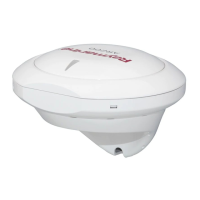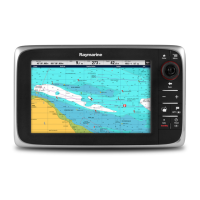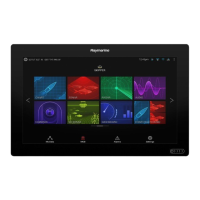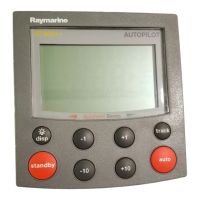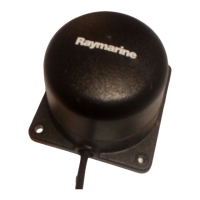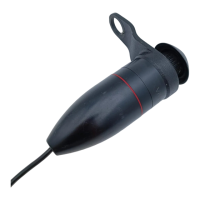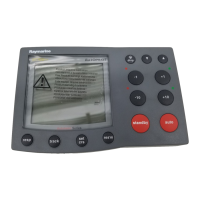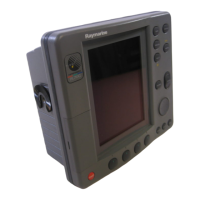16.1Radarapplicationoverviewand
features
RadioDetectionAndRanging(RADAR)isusedto
detectthepresence,distanceandspeedofobjects
(knownas‘targets’).Radarworksbytransmitting
radiopulses,thendetectingreectionsofthese
pulses(echoes)fromobjectsintheareaand
displayingthereectionsastargetsonyourdisplay.
Important:Untilyouarefamiliarwithinterpreting
theradardisplay;everyopportunityshouldbe
takentocomparetheradarscreenpatternswith
visualtargetssuchasothervessels,buoysand
coastalstructures.Youshouldpractiseharborand
coastalnavigationduringdaylighthoursandin
clearweatherconditions.
Description
1Radarstatusbar.
Thestatusbardisplaysthefollowing
information:
•Range
•Radarscannerserialnumber
•Gainmode
•Orientation
•Motionmode
•Rangeringspacing
2
Onscreencontrols(Touchscreen
multifunctiondisplaysonly.)
3
Ship'sHeadingMarker(SHM)
4
GuardZone
5
Radarstatus
6Databoxoverlay
7
Waypoint
8
Safezonering
9
Rangecontrols(Touchscreenmultifunction
displaysonly.)
10
Ship'sposition
AdditionalfunctionalityoftheRadarapplication
includes:
•Colorpalettes.
•AddingAISoverlay.
•MARPAtargets.
•VRM/EBLmarkers
Typically,yourvessel’spositionisatthecenterofthe
display,anditsdeadaheadbearingisindicatedbya
verticalheadingline,knownastheShip’sHeading
Marker(SHM).
Note:IfthecursorisplacedovertheSHM,the
SHMwilltemporarilyberemovedtohelpplacing
markersoracquiringtargetsetc.
Onscreentargetsmaybelarge,small,brightorfaint,
dependingonthesizeoftheobject,itsorientation
andsurface.Ifusinganon-HDdigitalradome
scanner,strongesttargetreturnsaredisplayedin
yellowwithweakerreturnsin2shadesofblue.If
usingaHDorSuperHDradarscanner,stronger
targetreturnsshowasdifferentcolorsfromarange
of256colors,providingbetterclarity.
Note:Colorsstatedaboverefertothedefault
colorpalette.
Beawarethatthesizeofatargetonscreenis
dependentonmanyfactorsandmaynotnecessarily
beproportionaltoitsphysicalsize.Nearbyobjects
mayappeartobethesamesizeasdistantlarger
objects.
Withexperience,theapproximatesizeofdifferent
objectscanbedeterminedbytherelativesizeand
brightnessoftheechoes.
Youshouldbearinmindthatthesizeofeach
onscreentargetisaffectedby:
•Thephysicalsizeofthereectingobject.
•Thematerialfromwhichtheobjectismade.
Metallicsurfacesreectsignalsbetterthan
non-metallicsurfaces.
•Verticalobjectssuchascliffsreectsignalsbetter
thanslopingobjectssuchassandbanks.
•Highcoastlinesandmountainouscoastal
regionscanbeobservedatlongerradarranges.
Therefore,therstsightoflandmaybeamountain
severalmilesinlandfromthecoastline.Although
thecoastlinemaybemuchnearer,itmaynot
appearontheradaruntilthevesseliscloserto
shore.
•Sometargets,suchasbuoysandsmallvessels
difculttodiscern,becausetheydonotpresenta
consistentreectingsurfaceastheybobandtoss
aboutinthewaves.Consequentlytheseechoes
tendtofadeandbrighten,andattimesdisappear
momentarily.
•Buoysandsmallvesselsresembleeachother,but
vesselscanoftenbedistinguishedbytheirmotion.
Note:AGPSreceiverandafastheadingsensor
arerequiredforMARPAoperation,andtoenable
radar/chartoverlay.
234
LightHousemultifunctiondisplayoperationinstructions
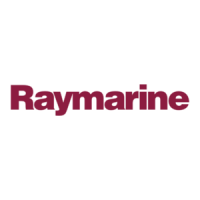
